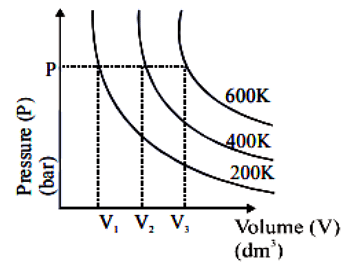Which among the following option is the correct graphical representation of Boyle's Law?
The Correct Option is B
Approach Solution - 1
Boyle's Law is a fundamental principle in chemistry and physics that describes the relationship between the pressure and volume of a gas at constant temperature. It can be mathematically expressed as:
PV = k
Where:
- P is the pressure of the gas.
- V is the volume of the gas.
- k is a constant.
Boyle's Law implies that pressure and volume are inversely proportional when temperature is held constant. This means if the volume increases, the pressure decreases, and vice versa, as long as the temperature does not change. The graphical representation of this inverse relationship is a curve (hyperbola) that starts high and slopes downwards, suggesting that when one parameter increases, the other decreases.
The correct option displays a graph of Pressure (P) versus Volume (V) showing a downward curve, which is characteristic of this inverse relationship.
Approach Solution -2
Boyle's law states:
P ∝ \(\frac {1}{V}\)
And at a specific pressure:
P ∝ T
Therefore, The correct option is (B)
Top Questions on States of matter
- The slope of isobar of one mole of an ideal gas at p (atm) is 0.082 L K$^{-1}$. What is the value of p in atm? (R=0.082 L atm mol$^{-1}$K$^{-1}$)
- TS EAMCET - 2025
- Chemistry
- States of matter
- Isotherms ($p$-$V$ lines) of one mole of an ideal gas at $T_1$ and $T_2$ have slope ratio 1:2. If $T_1=1000$ K, find $T_2$.
- TS EAMCET - 2025
- Chemistry
- States of matter
- At T(K) root mean square (rms) velocity of argon (molar mass 40 g mol⁻¹) is 20 ms⁻¹. The average kinetic energy of the same gas at T(K) (in J mol⁻¹) is
- TS EAMCET - 2025
- Chemistry
- States of matter
- Which of the following gases has the highest density at STP?
- VITEEE - 2025
- Chemistry
- States of matter
- What is the molar mass of a gas, if 2.5 g of the gas occupies 1.12 L at STP?
- MHT CET - 2025
- Chemistry
- States of matter
Questions Asked in NEET exam
- With the help of the given pedigree, find out the probability for the birth of a child having no disease and being a carrier (has the disease mutation in one allele of the gene) in the F3 generation.

- NEET (UG) - 2025
- Genetics
- The plates of a parallel plate capacitor are separated by d. Two slabs of different dielectric constant \(K_1\) and \(K_2\) with thickness \(d/2\) and \(d/2\) respectively are inserted in the capacitor. Due to this, the capacitance becomes two times larger than when there is nothing between the plates. If \(K_1 = 1.25 K_2\), the value of \(K_2\) is :
- NEET (UG) - 2025
- Capacitors and Capacitance
- The correct order of the wavelength of light absorbed by the following complexes is:
A. $[ \text{Co(NH}_3\text{)}_6]^{3+}$
B. $[ \text{Co(CN)}_6]^{3-}$
C. $[ \text{Cu(H}_2\text{O)}_4]^{2+}$
D. $[ \text{Ti(H}_2\text{O)}_6]^{3+}$
Choose the correct answer from the options given below:- NEET (UG) - 2025
- Coordination chemistry
- Consider the diameter of a spherical object being measured with the help of a Vernier Callipers. Suppose its 10 Vernier Scale Divisions (V.S.D.) are equal to its 9 Main Scale Divisions (M.S.D.). The least count in the M.S. is 0.1 cm and the zero of V.S. is at -0.1 cm when the jaws of Vernier callipers are closed. If the main scale reading for the diameter is \(M = 5\) cm and the number of coinciding vernier division is 8, the measured diameter after zero error correction, is:
- NEET (UG) - 2025
- Measurement of length
- In some appropriate units, time (t) and position (x) relation of a moving particle is given by \(t = \alpha x^2 + \beta x\). The acceleration of the particle is :
- NEET (UG) - 2025
- Kinematic equations for uniformly accelerated motion
Concepts Used:
States of Matter
The matter is made up of very tiny particles and these particles are so small that we cannot see them with naked eyes.
There are three States of Matter:
The three states of matter are as follows:
Solid State:
- The solid-state is one of the fundamental states of matter.
- Solids differ from liquids and gases by the characteristic of rigidity.
- The molecules of solids are tightly packed because of strong intermolecular forces; they only oscillate about their mean positions.
Liquid State:
- The molecules in a liquid are closely packed due to weak intermolecular forces.
- These forces are weaker than solids but stronger than that of gases.
- There is much space in between the molecules of liquids which makes their flowing ability easy.
Gaseous State:
- In this state of matter, distances between the molecules are large (intermolecular distance is in the range of 10-7-10-5 cm.
- The intermolecular forces experienced between them are negligible.
- Thus, translatory, rotatory and vibratory motions are observed prominently in gases.



